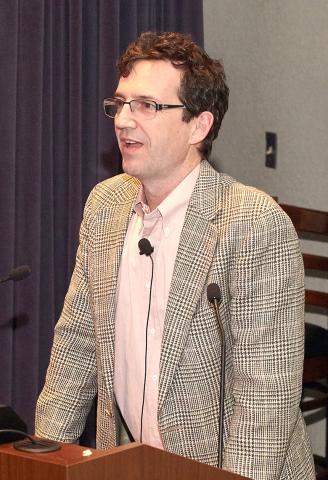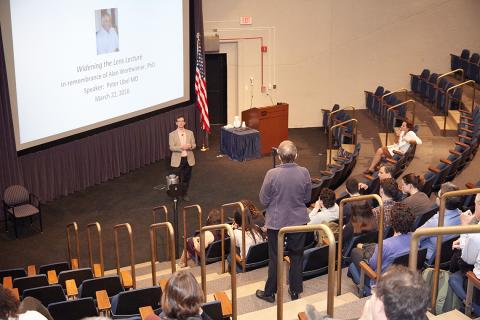Empowering Patients
How Doctors Can Embolden Patients to Choose the Right Treatment

Photo: Jeff Elkins
Does doctor always know best? Patients often ask their doctor: “What would you do in my situation?” But as the doctor explains the risks and benefits of treatment options and imparts advice, it’s important to remember there’s a human behind that medical chart, a patient with unique values, opinions and personal preferences.
A doctor’s recommendation often influences a patient’s treatment choice, so the clinician has a huge moral responsibility to recommend well, said Dr. Peter Ubel, a physician and behavioral scientist who teaches public policy and business at Duke University. He led an animated, thought-provoking discussion about shared decision-making among doctors and patients at a bioethics lecture Mar. 22 in Lipsett Amphitheater.
“People want to be heard and understood. That, to me, is what shared decision-making is; that’s what partnership is,” said Ubel, who helps prepare business students for jobs in health care. “What we need to do as clinicians is to get better at eliciting those patient preferences. [Clinicians should tell patients]: ‘I’m the expert on medical facts, but you’re the expert on you.’”
Ubel used the example of a patient with low-grade prostate cancer who was trying to decide between surveillance or surgery and radiation. Whether he chose the passive or active approach, the survival rate was the same. But with waiting comes anxiety, and with the medical procedures, he’d run the risk of incontinence and erectile dysfunction.
In this case, how worried was the patient about those side effects? What were his life goals? Asking these kinds of questions can help determine the best course of action. In a similar case, a patient said he preferred the watch-and-wait approach, that he could more easily pursue active treatment after he retired in a couple of years.
“All else equal, the treatment people receive should have something to do with what they care about and these baseline preferences,” said Ubel.
The doctor also should consider the patient’s reaction when delivering the diagnosis, said Ubel. In a urology office, a doctor told a patient he had slow-growing cancer, then tossed out a lot of convoluted, vague information. The doctor may think it’s not an aggressive case so it’s not bad news, but the patient probably only heard, “you’ve got cancer” and tuned out the rest.
People need time to recover from bad news before making an informed decision. Ubel warned that information overload reduces comprehension and retention, and ultimately affects the patient’s choice.

Photo: Jeff Elkins
“I think in part because of the way we’re taught in medical school about informed consent and patient autonomy, there’s this big emphasis on information,” said Ubel. “We inform the hell out of patients in jargon they can’t understand at a time when they’re not ready to take on complex information.”
If we have too many choices and too much information to process, Ubel said, people disengage. And patients might just ask for the doctor’s advice without really understanding the diagnosis and treatment alternatives.
“One of the problems with shared decision-making and promoting patient autonomy is that thorough communication is not always good communication,” he said. “Good communication takes time; it takes time to deliver it well and it takes time for the patient to absorb the information.”
In one survey, urologists said they only dispensed advice after gauging which way the patient was leaning. The urologists usually asked whether the patient had normal sexual function, but only 12 percent asked whether sexual function was important to the patient. And, astoundingly, only 13 percent said this preference should factor into deciding the right treatment. Look beyond age and test results, said Ubel; consider what patients care about.
Furthermore, doctors should admit their biases, said Ubel. In one survey, most urologists said they’d choose surgery over radiation, but the radiation oncologists said they’d choose radiation. These opinions affect patient choice and doctors should explain their reasoning.
Another point to consider is that we often make different choices for ourselves than we’d make for others. Ubel surveyed a healthy group, giving them the hypothetical scenario of having colon cancer. They could choose between 1 of 2 surgeries, both with an 80 percent cure rate. The first treatment had low-probability side effects, including permanent colostomy and chronic diarrhea, while the second option had no side effects but a 20 percent chance of death.
Some 40 percent of doctors said they’d choose the surgery with the higher death rate for themselves, but only 25 percent said they’d recommend that option to their patients. Meanwhile, most patients surveyed said they’d prefer the treatment with the unpleasant side effects, but in the survey, half actually picked the surgery with the higher death rate.
Ubel said more doctors should employ “teach-back,” a technique taught in medical schools in which the doctor explains a concept, asks the patient to explain it back and can then clarify misperceptions.
“I think we can learn a lot by hearing our own explanations through our patients’ voices,” he said.
Medical schools should have a broader curriculum that includes teaching communication skills and the psychology of decision-making, he suggested.
“I think many physicians today think of informed consent or shared decision-making or respecting patient autonomy as meaning an [obligation to] impart a tremendous amount of information to patients so they can be fully empowered to make a choice.” But Ubel says that strategy doesn’t always work.
When a patient asks, “What treatment would you choose,” Ubel said doctors should ask probing questions and, when recommending a particular treatment, fully explain why.
